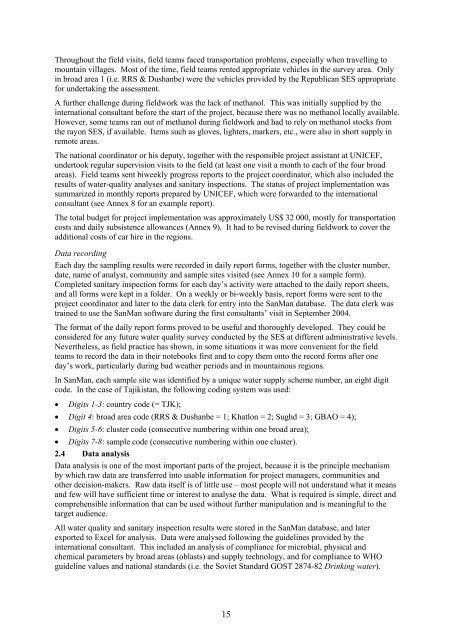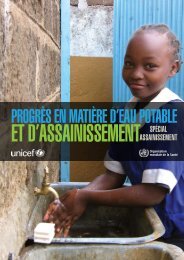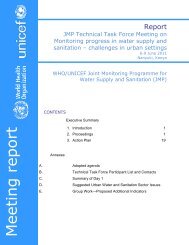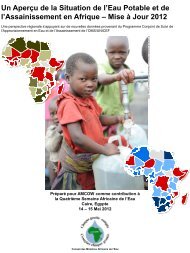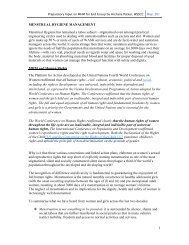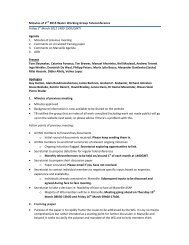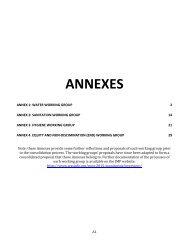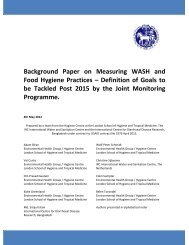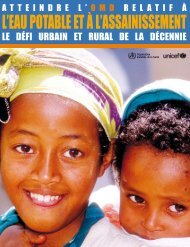rapid assessment of drinking-water quality in the republic of tajikistan
rapid assessment of drinking-water quality in the republic of tajikistan
rapid assessment of drinking-water quality in the republic of tajikistan
Create successful ePaper yourself
Turn your PDF publications into a flip-book with our unique Google optimized e-Paper software.
Throughout <strong>the</strong> field visits, field teams faced transportation problems, especially when travell<strong>in</strong>g to<br />
mounta<strong>in</strong> villages. Most <strong>of</strong> <strong>the</strong> time, field teams rented appropriate vehicles <strong>in</strong> <strong>the</strong> survey area. Only<br />
<strong>in</strong> broad area 1 (i.e. RRS & Dushanbe) were <strong>the</strong> vehicles provided by <strong>the</strong> Republican SES appropriate<br />
for undertak<strong>in</strong>g <strong>the</strong> <strong>assessment</strong>.<br />
A fur<strong>the</strong>r challenge dur<strong>in</strong>g fieldwork was <strong>the</strong> lack <strong>of</strong> methanol. This was <strong>in</strong>itially supplied by <strong>the</strong><br />
<strong>in</strong>ternational consultant before <strong>the</strong> start <strong>of</strong> <strong>the</strong> project, because <strong>the</strong>re was no methanol locally available.<br />
However, some teams ran out <strong>of</strong> methanol dur<strong>in</strong>g fieldwork and had to rely on methanol stocks from<br />
<strong>the</strong> rayon SES, if available. Items such as gloves, lighters, markers, etc., were also <strong>in</strong> short supply <strong>in</strong><br />
remote areas.<br />
The national coord<strong>in</strong>ator or his deputy, toge<strong>the</strong>r with <strong>the</strong> responsible project assistant at UNICEF,<br />
undertook regular supervision visits to <strong>the</strong> field (at least one visit a month to each <strong>of</strong> <strong>the</strong> four broad<br />
areas). Field teams sent biweekly progress reports to <strong>the</strong> project coord<strong>in</strong>ator, which also <strong>in</strong>cluded <strong>the</strong><br />
results <strong>of</strong> <strong>water</strong>-<strong>quality</strong> analyses and sanitary <strong>in</strong>spections. The status <strong>of</strong> project implementation was<br />
summarized <strong>in</strong> monthly reports prepared by UNICEF, which were forwarded to <strong>the</strong> <strong>in</strong>ternational<br />
consultant (see Annex 8 for an example report).<br />
The total budget for project implementation was approximately US$ 32 000, mostly for transportation<br />
costs and daily subsistence allowances (Annex 9). It had to be revised dur<strong>in</strong>g fieldwork to cover <strong>the</strong><br />
additional costs <strong>of</strong> car hire <strong>in</strong> <strong>the</strong> regions.<br />
Data record<strong>in</strong>g<br />
Each day <strong>the</strong> sampl<strong>in</strong>g results were recorded <strong>in</strong> daily report forms, toge<strong>the</strong>r with <strong>the</strong> cluster number,<br />
date, name <strong>of</strong> analyst, community and sample sites visited (see Annex 10 for a sample form).<br />
Completed sanitary <strong>in</strong>spection forms for each day’s activity were attached to <strong>the</strong> daily report sheets,<br />
and all forms were kept <strong>in</strong> a folder. On a weekly or bi-weekly basis, report forms were sent to <strong>the</strong><br />
project coord<strong>in</strong>ator and later to <strong>the</strong> data clerk for entry <strong>in</strong>to <strong>the</strong> SanMan database. The data clerk was<br />
tra<strong>in</strong>ed to use <strong>the</strong> SanMan s<strong>of</strong>tware dur<strong>in</strong>g <strong>the</strong> first consultants’ visit <strong>in</strong> September 2004.<br />
The format <strong>of</strong> <strong>the</strong> daily report forms proved to be useful and thoroughly developed. They could be<br />
considered for any future <strong>water</strong> <strong>quality</strong> survey conducted by <strong>the</strong> SES at different adm<strong>in</strong>istrative levels.<br />
Never<strong>the</strong>less, as field practice has shown, <strong>in</strong> some situations it was more convenient for <strong>the</strong> field<br />
teams to record <strong>the</strong> data <strong>in</strong> <strong>the</strong>ir notebooks first and to copy <strong>the</strong>m onto <strong>the</strong> record forms after one<br />
day’s work, particularly dur<strong>in</strong>g bad wea<strong>the</strong>r periods and <strong>in</strong> mounta<strong>in</strong>ous regions.<br />
In SanMan, each sample site was identified by a unique <strong>water</strong> supply scheme number, an eight digit<br />
code. In <strong>the</strong> case <strong>of</strong> Tajikistan, <strong>the</strong> follow<strong>in</strong>g cod<strong>in</strong>g system was used:<br />
Digits 1-3: country code (= TJK);<br />
Digit 4: broad area code (RRS & Dushanbe = 1; Khatlon = 2; Sughd = 3; GBAO = 4);<br />
Digits 5-6: cluster code (consecutive number<strong>in</strong>g with<strong>in</strong> one broad area);<br />
Digits 7-8: sample code (consecutive number<strong>in</strong>g with<strong>in</strong> one cluster).<br />
2.4 Data analysis<br />
Data analysis is one <strong>of</strong> <strong>the</strong> most important parts <strong>of</strong> <strong>the</strong> project, because it is <strong>the</strong> pr<strong>in</strong>ciple mechanism<br />
by which raw data are transferred <strong>in</strong>to usable <strong>in</strong>formation for project managers, communities and<br />
o<strong>the</strong>r decision-makers. Raw data itself is <strong>of</strong> little use – most people will not understand what it means<br />
and few will have sufficient time or <strong>in</strong>terest to analyse <strong>the</strong> data. What is required is simple, direct and<br />
comprehensible <strong>in</strong>formation that can be used without fur<strong>the</strong>r manipulation and is mean<strong>in</strong>gful to <strong>the</strong><br />
target audience.<br />
All <strong>water</strong> <strong>quality</strong> and sanitary <strong>in</strong>spection results were stored <strong>in</strong> <strong>the</strong> SanMan database, and later<br />
exported to Excel for analysis. Data were analysed follow<strong>in</strong>g <strong>the</strong> guidel<strong>in</strong>es provided by <strong>the</strong><br />
<strong>in</strong>ternational consultant. This <strong>in</strong>cluded an analysis <strong>of</strong> compliance for microbial, physical and<br />
chemical parameters by broad areas (oblasts) and supply technology, and for compliance to WHO<br />
guidel<strong>in</strong>e values and national standards (i.e. <strong>the</strong> Soviet Standard GOST 2874-82 Dr<strong>in</strong>k<strong>in</strong>g <strong>water</strong>).<br />
15


